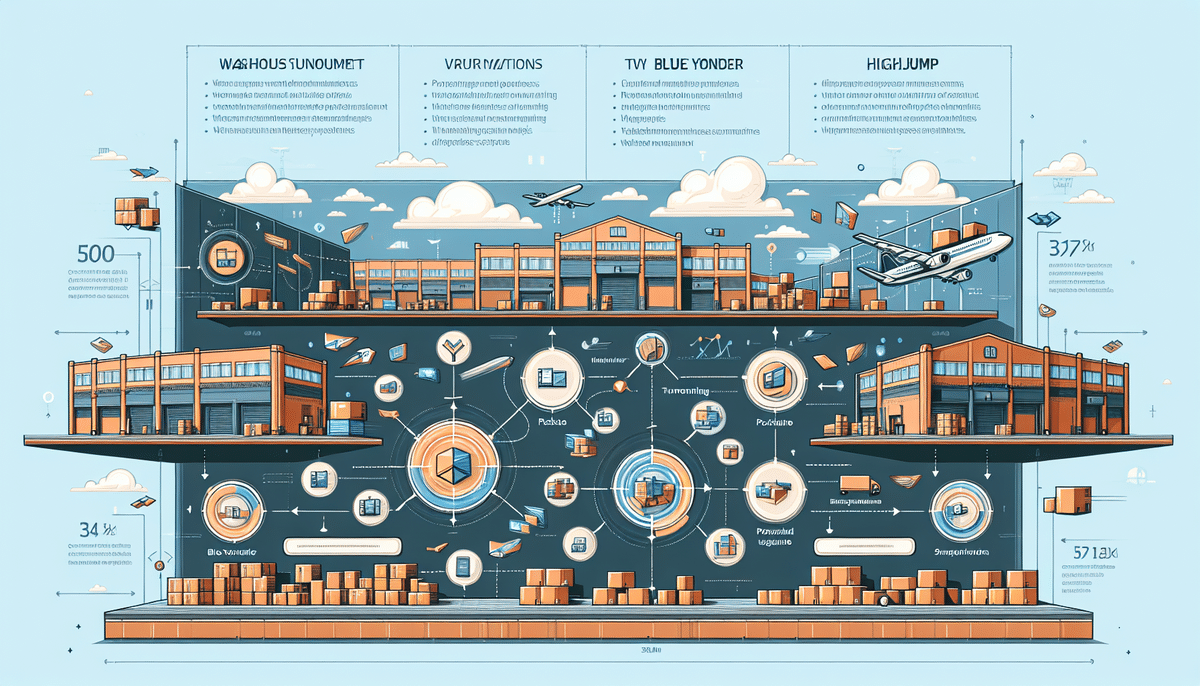Introduction to Warehouse Management Systems (WMS)
In today's fast-paced logistics and supply chain environment, owning a warehouse or managing a logistics business necessitates the use of a Warehouse Management System (WMS). A WMS software is indispensable for controlling and managing day-to-day warehouse activities, including inventory management, order processing, and shipping. With an array of options available in the market, selecting the optimal WMS for your business can be overwhelming. This article provides a comparative analysis of two leading WMS solutions, Blue Yonder (formerly JDA Software) WMS and HighJump WMS (now part of Körber), to aid you in making an informed decision.
Why Your Business Needs a Warehouse Management System (WMS)
A Warehouse Management System is a software solution that offers real-time visibility into a warehouse's inventory levels and processes workflows to optimize productivity. By automating warehouse operations, a WMS streamlines processes, reduces labor costs, and minimizes errors. According to a 2023 report by Gartner, businesses implementing a WMS experience a 20% increase in operational efficiency and a 15% reduction in inventory costs.
Key benefits of a WMS include:
- Enhanced Inventory Accuracy: Real-time tracking and automated processes ensure precise inventory management.
- Improved Order Fulfillment: Efficient order processing leads to faster delivery times and higher customer satisfaction.
- Labor Cost Reduction: Automation reduces the need for manual labor, lowering operational costs.
- Scalability: A scalable WMS can adapt to the growing needs of a business, accommodating increased volumes and additional warehouse locations.
Furthermore, a WMS provides valuable data and analytics that inform strategic decisions related to inventory management, staffing, and overall warehouse operations. This data-driven approach allows businesses to identify inefficiencies and continuously optimize their processes.
Blue Yonder WMS: Features and Benefits
Blue Yonder WMS, formerly known as JDA Software, is a leading warehouse management system renowned for its comprehensive suite of features designed to enhance warehouse operations. Suitable for businesses of all sizes, Blue Yonder WMS offers a user-friendly interface and real-time data insights that empower businesses to make informed decisions and optimize their supply chain.
Advanced Analytics and Predictive Capabilities
Blue Yonder WMS boasts advanced analytics that provide detailed insights into warehouse operations, including inventory levels, order fulfillment rates, and labor productivity. Additionally, its predictive analytics feature leverages machine learning algorithms to forecast demand, enabling proactive inventory planning. According to a case study by Supply Chain Digital, companies utilizing Blue Yonder WMS have reported a 25% improvement in inventory turnover.
Comprehensive Integration
The software seamlessly integrates with major Enterprise Resource Planning (ERP) systems like Oracle and SAP, ensuring smooth data flow across different business functions. This integration capability enhances overall operational efficiency and minimizes data silos within the organization.
Customizable Modules
Blue Yonder WMS offers various modules, including yard management, labor management, transportation management, and warehouse labor planning. These modules are highly customizable, allowing businesses to tailor the system to their specific needs and workflows.
HighJump WMS: Features and Benefits
HighJump WMS, now part of Körber, is another top-tier warehouse management system known for its flexibility and robust feature set. As a cloud-based solution, HighJump WMS provides increased agility and ease of access, making it an attractive option for modern warehouses.
Cloud-Based Flexibility
HighJump WMS is built on a cloud infrastructure, offering unparalleled flexibility and scalability. Businesses can easily scale their operations up or down based on demand without the need for significant upfront investments in hardware. This cloud-based approach also facilitates remote access and real-time updates, ensuring that warehouse managers have the most current information at their fingertips.
Integration and Automation
The system excels in integrating with other software solutions, including ERP and Customer Relationship Management (CRM) systems. HighJump WMS also supports advanced automation by integrating with robotics and other automated technologies, enhancing operational efficiency and reducing manual workloads.
Mobile Accessibility
HighJump WMS features a mobile application that allows warehouse workers to access the system from their mobile devices. This functionality enables employees to perform tasks on-the-go, increasing efficiency and reducing the likelihood of errors. Real-time updates ensure that workers have access to the latest information, fostering better decision-making.
Comparative Analysis: Blue Yonder vs HighJump WMS
Pricing Models
Blue Yonder typically charges a higher upfront cost but offers extensive customization and scalability options, making it suitable for large enterprises with complex supply chains. HighJump WMS presents a more affordable pricing structure, which can be more appealing to small and medium-sized businesses.
Customization and Flexibility
While both systems offer customization, HighJump WMS provides greater flexibility, allowing businesses to tailor the software more precisely to their specific needs. Blue Yonder offers robust features but may require additional investment for extensive customization.
Integration Capabilities
Both WMS solutions offer strong integration capabilities with ERP systems. HighJump, however, excels in integrating with a broader range of software solutions, offering more seamless data flow across various platforms.
User Interface and Ease of Use
HighJump WMS is noted for its intuitive and user-friendly interface, making it easier for employees to adopt and use the system effectively. Blue Yonder WMS, while comprehensive, may present a steeper learning curve due to its extensive features.
Customer Support and Training
Blue Yonder is renowned for its comprehensive training programs and dedicated support teams, ensuring that businesses can maximize the potential of the WMS. HighJump offers robust support and a wealth of online resources, though some users may find it requires more technical expertise.
Choosing the Right WMS for Your Business
Selecting the appropriate WMS depends on various factors, including your business size, budget, operational complexity, and specific needs. Consider the following when making your decision:
- Business Size: Large enterprises with complex operations may benefit more from Blue Yonder's extensive features, while small to medium-sized businesses may find HighJump's flexibility and affordability more suitable.
- Budget: Assess the total cost of ownership, including upfront costs, customization, and ongoing maintenance.
- Integration Needs: Ensure the WMS can seamlessly integrate with your existing ERP and other software systems.
- Scalability: Choose a system that can grow with your business and handle increasing volumes and additional warehouse locations.
- Support and Training: Evaluate the level of customer support and training provided to ensure smooth implementation and user adoption.
Additionally, consider the level of automation and advanced features each WMS offers. Blue Yonder’s machine learning and artificial intelligence capabilities can significantly optimize warehouse operations, while HighJump’s customizable and flexible solutions allow for tailored workflows that meet specific business requirements.
Success Stories: Companies Benefiting from Blue Yonder and HighJump WMS
Both Blue Yonder and HighJump WMS have a rich portfolio of success stories from various industries:
- Blue Yonder: Walmart, Amazon, and Coca-Cola have leveraged Blue Yonder WMS to streamline their warehouse operations, leading to significant improvements in inventory accuracy and order fulfillment efficiency.
- HighJump WMS: Companies like Puma, Stanley Black & Decker, and McDonald's have successfully implemented HighJump WMS to enhance their warehouse management, resulting in increased operational agility and reduced costs.
These success stories underscore the effectiveness of both WMS solutions in driving operational excellence and supporting business growth.
Conclusion: Making an Informed Decision
Choosing between Blue Yonder and HighJump WMS requires a thorough evaluation of your business's unique needs, budget, and operational requirements. Based on our comparative analysis, HighJump WMS emerges as a more cost-effective and flexible solution, ideal for businesses seeking customization, easy integration, and intuitive design. Conversely, Blue Yonder WMS offers a more comprehensive and industry-specific solution, suitable for large enterprises with complex supply chains and substantial data management needs. Both systems are capable of optimizing warehouse operations, enhancing productivity, and improving the bottom line. By carefully assessing your business priorities and leveraging the strengths of each WMS, you can select the solution that best aligns with your operational goals.




















